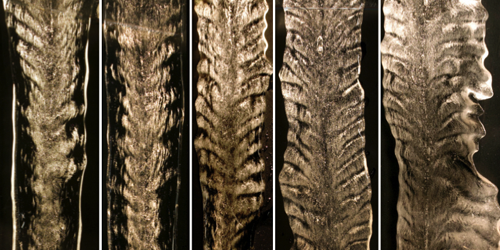Icicle Structure Reveals Growth Dynamics
Icicles might seem an unlikely source of sustained inspiration, but they have occupied Stephen Morris on and off for more than a decade (see Synopsis: Freeze Frame). One feature that has eluded description is the horizontal surface ripples that sometimes develop as an icicle grows. Morris and his colleague John Ladan, both at the University of Toronto, have now identified the mechanism by which such ripples form on lab-grown icicles [1]. Morris notes, however, that the cause of the underlying instability remains unknown.
In earlier experiments, Morris and colleagues discovered two important clues about icicle ripples: they only develop when an icicle forms from water that contains impurities, and their formation requires that water flows down the icicle’s surface in discrete rivulets rather than as a continuous layer of fluid.
In the latest experiment, Morris and Ladan grew icicles using water with various impurity concentrations. They then melted each icicle from two directions to expose an axial cross section of the icicle’s core. This sectioning revealed that rippled icicles contain a series of chevron-like internal structures that connect to the ripples at the surface. These chevrons are each composed of a series of crescent-shaped inclusions of liquid water in which the dissolved impurity is concentrated.
The duo thinks that these chevrons record the process by which flowing water accumulates on the upper surfaces of ripples before freezing. Morris hopes that their result will encourage experiments and modeling by other groups, which might uncover why the ripples form in the first place and what determines their wavelength.
–Marric Stephens
Marric Stephens is a Corresponding Editor for Physics Magazine based in Bristol, UK.
References
- J. Ladan and S. W. Morris, “Pattern of inclusions inside rippled icicles,” Phys. Rev. E 106, 054211 (2022).




